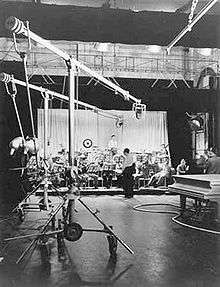Hyam Greenbaum
Hyam Greenbaum (12 May 1901 – 13 May 1942) was an English conductor, violinist and composer who in 1936 became the world's first conductor of a television orchestra.[1] He was friendly with many of his English music contemporaries, including Constant Lambert, Alan Rawsthorne, and William Walton and often helped them with technical advice on orchestration.[2] His sister was the pianist and composer Kyla Greenbaum (1922-2017).

Career
As a child Greenbaum was taught violin by his mother and piano by his father (Solomon Greenbaum, a tailor of Polish origins)[3] before studying at the Brighton School of Music and the Royal College of Music.[4] Although he had ambitions to become a conductor from the start, Greenbaum began his musical career in 1916 leading the second violins in the Queen's Hall Orchestra,[5] and from 1923 until 1936 played second violin and piano for the Diaghilev Ballet.[4] In 1924 he joined the Brosa String Quartet playing second violin. From 1930 until 1934 he was a music director for C. B. Cochran on London productions such as Jerome Kern's The Cat and the Fiddle (March 1932, 219 performances), Kern's Music in the Air (May 1933, 275 performances) and Cole Porter's Nymph Errant (October 1933, 154 performances).[6] In the early 1930s he also joined Decca as a recording manager.[7]
In 1936 Greenbaum founded the BBC Television Orchestra, which played on the inaugural programme broadcast when regular British television broadcasts commenced on 26 August 1936 to an estimated 123,000 viewers.[1] This was the first high-definition standard (405 lines) television test transmission, with the orchestra broadcasting from Alexandra Palace to the Radiolympia exhibition being held at Olympia London.[8][9] The orchestra also played on the opening day of BBC Television high-definition broadcast on 2 November 1936.[10][11] Its repertoire was wide, ranging from music for drama productions through to a televised adaptation of Tristan und Isolde (in two one-hour sections) on 24 January 1938.[12] Greenbaum, with a group of others at the BBC (including Stephen Thomas, Dallas Bower, Desmond Davis and members of the British Music Drama Opera Company), presented 29 operas on television between 1936 and 1939.[13]
The orchestra was disbanded in September 1939 at the outbreak of World War II when the BBC's television service was suspended, after which Greenbaum used a nucleus of its players to form the BBC Revue Orchestra, playing light variety music for BBC radio from its base in Bangor, North Wales.[7] However, he continued to conduct a wide range of repertoire for the BBC with other orchestras. For instance, on 19 November 1941 he conducted Franz Liszt's symphonic poem Orpheus and Ferruccio Busoni's Violin Concerto.[14]
Composition and orchestration
Greenbaum was a member of the "Warlock Gang", followers of composer and music critic Peter Warlock (Philip Heseltine).[15] Others were Cecil Gray, E. J. Moeran, Constant Lambert and Leslie Heward. It has been suggested that Heseltine's influence led to Greenbaum's heavy drinking habit. In the late 1920s and early 1930s, the London home of Hyam Greenbaum and his wife, the harpist Sidonie Goossens, became a regular meeting place for an expanded circle of hard-drinking musicians, also including Arnold Bax, Patrick Hadley, Spike Hughes, Alan Rawsthorne and William Walton. During the war they moved to Bristol, living with Rawsthorne and his wife Jessie Hinchcliffe at the Clifton Arts Club.[16] This was bombed in November 1940, and many of Rawsthorne’s manuscripts were destroyed.
As a composer, Greenbaum achieved some recognition with his Parfums de Nuits for oboe and orchestra[17] which was performed at the Proms on 12 October 1922.[18] He then conducted the premiere of his orchestral piece A Sea Poem at the 1923 Proms, repeating it the following year.[19] However, his greatest contributions to contemporary music came from his conducting and orchestration work, and from helping other composers at difficult times in the composition process. He orchestrated some of William Walton's film scores, including Escape Me Never in 1935 and As You Like It in 1936[20] and assisted Walton with both the Viola Concerto and the Symphony No 1.[21][22] Similarly, he helped Constant Lambert complete his choral work Summer's Last Will and Testament, also standing in as conductor for the second performance when Lambert was too ill to appear himself.[7]
Geenbaum married Sidonie Goossens in 1924. He died of alcohol-related problems, one day after his 41st birthday, following the death of their only son at birth.[23]
References
- Obituary, Sidonie Goossens, Daily Telegraph, 16 December, 2004
- Spike Hughes, Opening Bars (1946) p 354-5
- Marston, John: Sidonie Goossens, in the Oxford Dictionary of National Biography, 2009
- Rubenstein, W. (ed.) The Palgrave Dictionary of Anglo-Jewish History (2011)
- Radio Times, Issue 894, 28 February 1939, p 24
- London Musicals, 1930-34
- Lloyd, Stephen. Constant Lanbert: Beyond The Rio Grande (2015)
- "The History of the BBC: The first TV era". Television Heaven. Retrieved 26 December 2018.
- "History of the BBC - The Story of the BBC - Television As We Know It". BBC. BBC. Retrieved 23 November 2016.
- The History of the BBC
- "BBC liner notes, 1936". Archived from the original on 21 April 2008.
- Radio Tines, Issue 747, 23 January 1938, p 16
- Salter, Lionel and others: 'Television' in Grove Music Online
- Radio Times Issue 946, 16 November 1941, p 14
- Lloyd, Stephen (ed.). Music in Their Time: The Memoirs and Letters of Dora and Hubert Foss (2019)
- 'The Creel, Vol 8 No 2 (2016) p 3
- Philip Scowcroft, Musicweb International
- BBC Proms performance archive
- BBC Proms performance archive
- Oxford Reference
- Lloyd, Stephen. William Walton, Muse of Fire (2001), p 112
- Gray, Cecil: Hyam Greenbaum (1901-42), The Music Review 3(3), August 1942, p 221-222
- Sidonie Goossens obituary, The Independent, 16 December, 2004